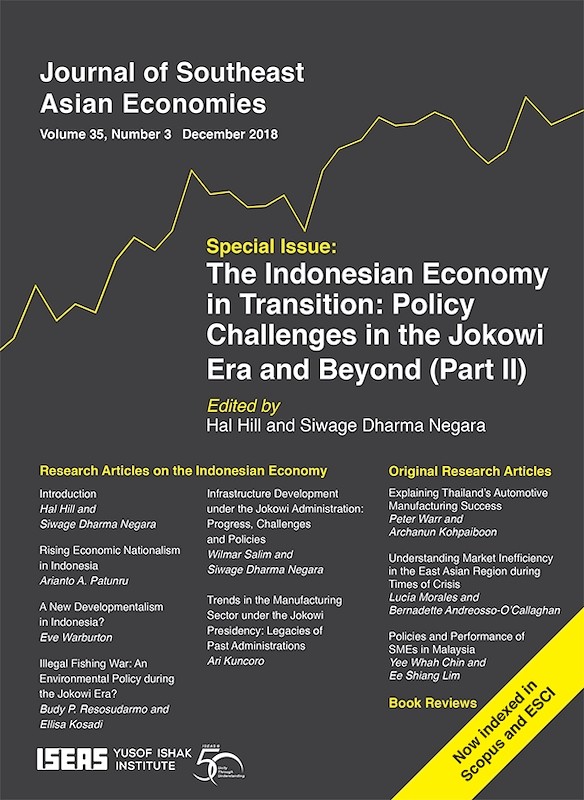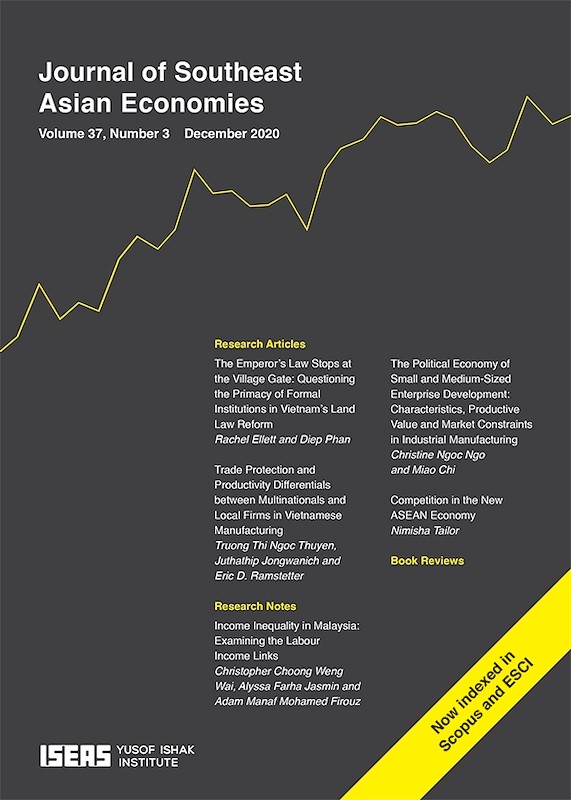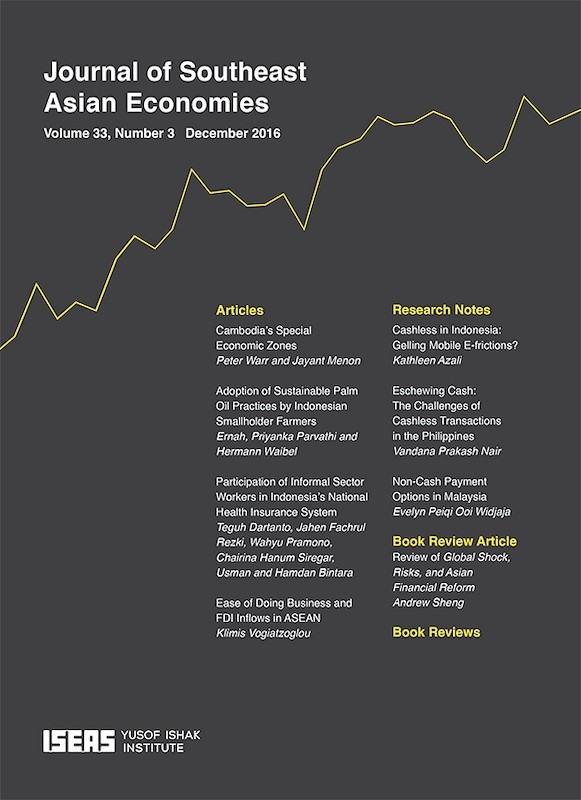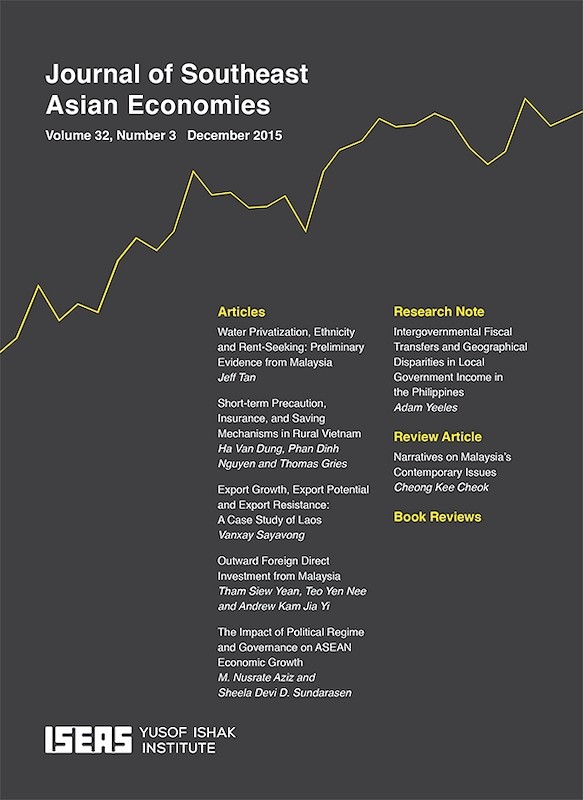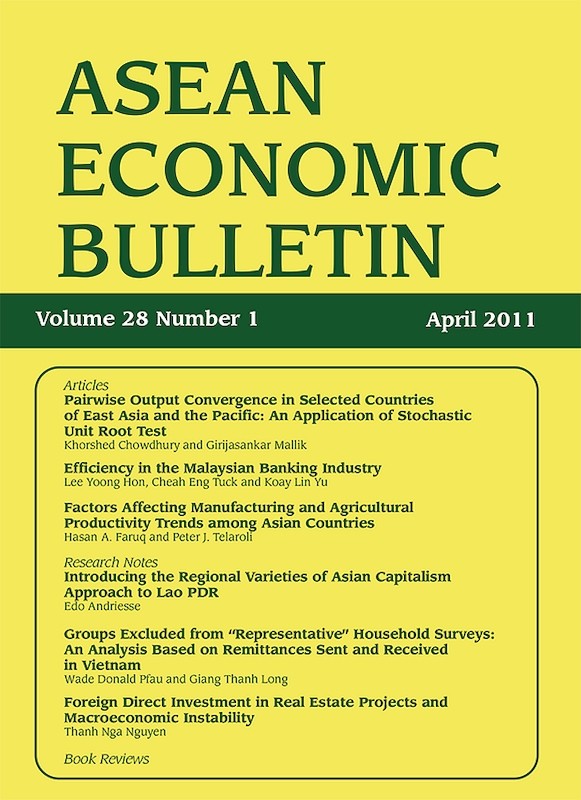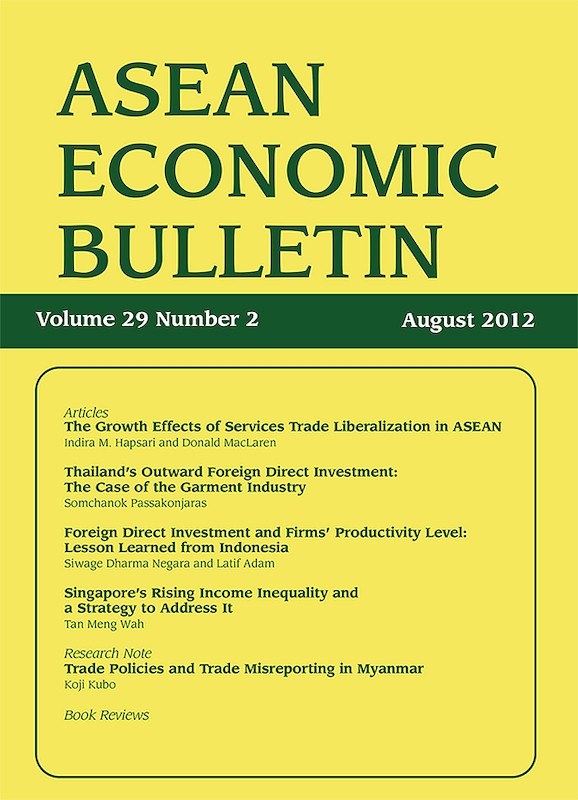Journal of Southeast Asian Economies Vol. 34/3 (Dec 2017). Special Issue: "The Malaysian Economy Towards 2020 and Beyond"
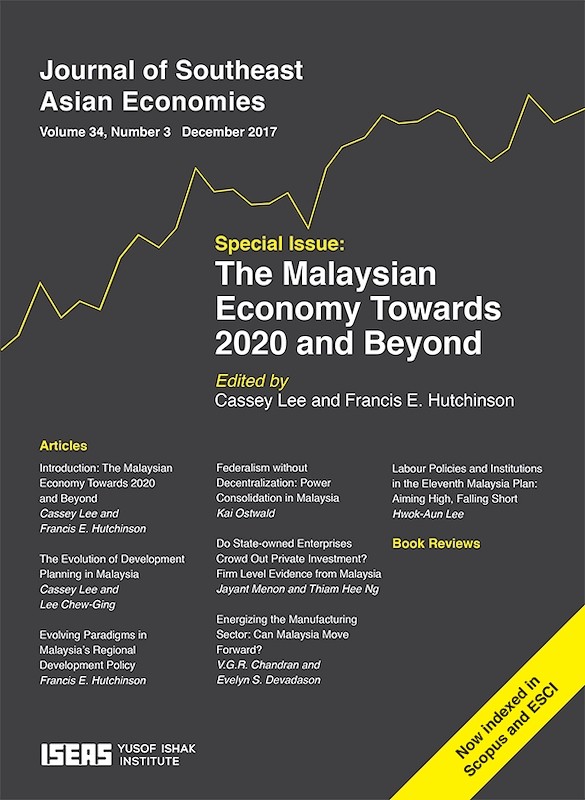
Date of publication:
December 2017
Publisher:
ISEAS – Yusof Ishak Institute
Number of pages:
154
Code:
AE34/3
Contents
-
Journal of Southeast Asian Economies Vol. 34/3 (Dec 2017). Special Issue: "The Malaysian Economy Towards 2020 and Beyond"
[Whole Publication, ISSN: 23395206] -
Preliminary pages
- ARTICLES
-
1. Introduction: The Malaysian Economy Towards 2020 and Beyond, by Cassey Lee, Francis E Hutchinson, authors
-
2. The Evolution of Development Planning in Malaysia, by Cassey Lee, Lee Chew Ging, authors see abstractThe primary objective of this paper is to trace the evolution of five-year development plans that have been formulated in Malaysia since the 1950s. Both internal and external factors have influenced the formulation and implementation of these plans. State bureaucracies played a crucial role in implementing the New Economic Policy in the 1970s. Economic reforms in the 1980s then reduced the independence of the planning bureaucracy by making bureaucrats more project-oriented and under the control of politicians. The corporate restructuring that followed the Asian Financial Crisis brought about greater involvement of corporate technocrats from Government Investment Companies (GICs) and Government Linked Companies (GLCs). Economic policy-making changed further under the Najib administration with increased centralization of development expenditure in the Prime Ministers Department and greater use of private consultants. The current trajectory suggests a more centralized and flexible, but less transparent, approach to development planning.
-
3. Evolving Paradigms in Malaysia's Regional Development Policy, by Francis E Hutchinson, author see abstractBeyond fostering economic growth, policymakers in Malaysia have had to grapple conceptually and operationally with income inequalities between different parts of the country. Beyond its complexity, this challenge has also changed over time — in line with Malaysia's increasing wealth and urbanization, and as understandings of what regional development is and how it should be pursued have evolved. Through a detailed study of central government planning documents and budgetary allocations, this article will analyse the targets, priorities, and approaches of Malaysian regional development policy as well as its evolution. The country's regional policy has evolved from an a-spatial understanding of economic growth, an exclusive focus on rural development, and a donor-recipient approach to minimizing internal income disparities towards a deeper understanding of the relationship between location and economic activity, a greater focus on urbanization and specific cities, and a growth oriented approach where all regions are encouraged to leverage their comparative advantage. While some aspects of this evolution mirror those witnessed in other countries, others may be at odds with the country's current governance structure.
-
4. Federalism without Decentralization: Power Consolidation in Malaysia, by Kai Ostwald, author see abstractMalaysia has a federal structure of government, suggesting substantial decentralization. In practice, however, the autonomy of subnational tiers has been systematically undermined through a range of mechanisms examined in this paper, creating a system that is highly centralized in practice. With power concentrated in the Prime Minister's Department, the elite core of the dominant United Malays National Organization (UMNO) has increased its resilience to political challenges from within and beyond the party. This has come at the expense of developmental gains subnational governments have insufficient fiscal and administrative capacities to efficiently leverage the theoretical advantages of decentralized decision making. In short, the relationship between tiers of government is optimized to preserve the power of the UMNO elite, rather than deliver governance improvements and comprehensive growth; this has negative implications for Malaysia's ability to escape the middle-income trap.
-
5. Do State-Owned Enterprises Crowd Out Private Investment? Firm Level Evidence from Malaysia, by Jayant Menon, Thiam Hee Ng, authors see abstractPrivate investment in Malaysia has been sluggish since the Asian Financial Crisis. One explanation is that the growing presence of state-owned enterprises (SOEs) or government-linked corporations (GLCs) has been crowding out private investment. For the first time, we provide empirical evidence on the relationship between GLC presence and private investment, employing a unique database covering 443 firms between 2007 and 2011. We find that when GLCs are dominant in an industry, investment by private firms is significantly negatively affected. Conversely, when GLCs do not dominate an industry, the impact on private investment is not seen. Sensitivity tests associated with varying the level of the threshold used to determine dominance confirm the robustness of the results. To revive private investment in Malaysia, the government must not only redress its growing fiscal deficit, but also expedite its programme of divestment.
-
6. Energizing the Manufacturing Sector: Can Malaysia Move Forward?, by J M Chandran, Evelyn S. Devadason, authors see abstractThe paper reviews and assesses the performance of the manufacturing sector in general, as well as the catalytic industries identified in the Eleventh Malaysia Plan (11MP), to ascertain whether the initiatives and targets proposed in the Plan are adequate to energize and move the sector forward. In doing so, the paper uses industrial policy arguments — market and government failures — to explain the slow progress of the sector. The findings suggest that market failures — in terms of lagging industrial capabilities and economies of scale, market frictions, lack of support for self-discovery by firms and diversification — require government intervention. Nevertheless, defying comparative advantage and identifying frontier products that show lacklustre performance to spearhead the sector under the Plan certainly require substantial improvements in institutional capabilities, coordination and institutional learning, while maintaining respect for markets and incentives. The paper concludes that lack of recognition to address government failures limited the success of policies implemented.
-
7. Labour Policies and Institutions in the Eleventh Malaysia Plan: Aiming High, Falling Short, by Lee Hwok-Aun, author see abstractThis paper examines the progress and shortfalls in Malaysia's labour markets and institutions, and the policies proposed in the Eleventh Malaysia Plan (11MP). While the economy has steadily grown, labour market institutions and policies distinctly lag behind the standards, productivity levels and regulatory efficacy of advanced economies. Commitments to promote productivity and wage growth, boost employment especially for women and young workers, enhance labour market information and improve foreign labour management are welcome. Nonetheless, the 11MP insufficiently confronts labour market structures that perpetuate insecure, indirect and transient employment and overwork, impeding overall productivity gains and prolonging dependency on low-skilled migrant labour. Higher goals and deeper shifts are needed not only to increase productivity and wages per hour as the driving purpose, but also to institute laws and policies overseeing fairness, equality, discrimination, worker representation, social protection and gainful part-time employment.
- BOOK REVIEWS
-
BOOK REVIEW: Education, Industrialization and the End of Empire in Singapore, by Kevin Blackburn, by Edgar Liao, author
-
BOOK REVIEW: The Haze Problem in Southeast Asia: Palm Oil and Patronage, by Helena Varkkey, by Lee Poh Onn, author
-
BOOK REVIEW: The Evolution of Central Banking and Monetary Policy in the Asia-Pacific, by Akhand Akhtar Hossain, by Sasidaran Gopalan, author
-
BOOK REVIEW: The Everyday Political Economy of Southeast Asia, edited by Juanita Elias and Lena Rethel, by Nursyazwani Jamaludin, author
-
BOOK REVIEW: Asian Port Cities: Uniting Lands and Water Worlds, by Sharon Siddique , by Mark Heng Shu Xun, author

